Introduction
In the world of pollination, many species contribute to the sustenance of ecosystems, yet few are as remarkable and influential as the apple hawkmoth. While this moth may appear delicate, its environmental role is anything but insignificant. The apple hawkmoth is a nocturnal pollinator, crucial for the reproduction of various plants, including apple trees. Its ecological niche spans a range of environmental contributions, including pollination, nutrient cycling, and serving as prey for larger predators. Understanding its life cycle, behavioral adaptations, and the challenges it faces is critical for preserving this vital insect and ensuring the health of the ecosystems it supports.
In this article, we will explore the apple hawkmoth’s taxonomy, its role in the food web, its feeding behaviors, the habitats it occupies, its survival strategies, and the mounting threats it faces due to human activities. This comprehensive analysis underscores the need for conservation efforts to protect this remarkable species.
1. Taxonomy and Morphological Characteristics
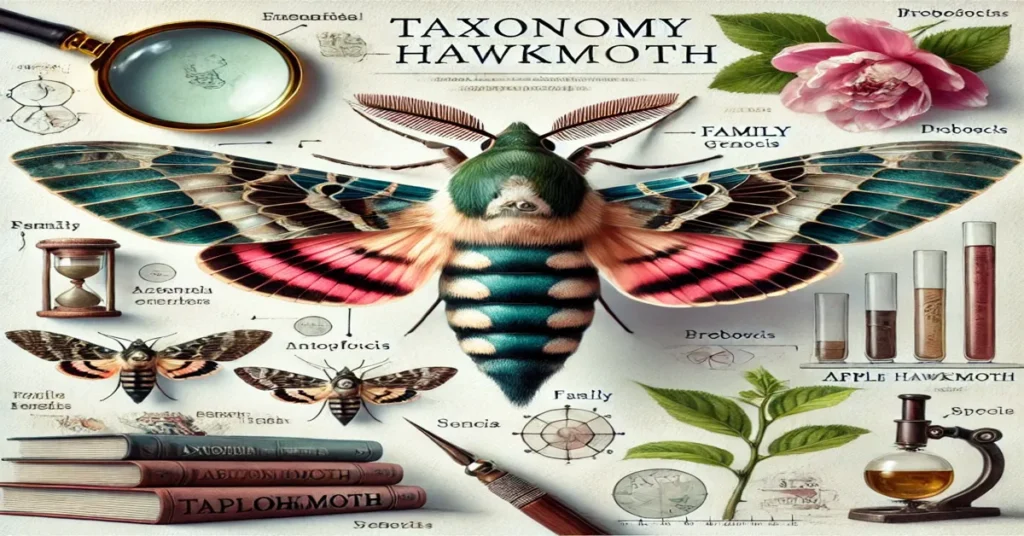
Taxonomic Classification
The apple hawkmoth is a member of the Sphingidae family, a group of moths known for their remarkable flight abilities and distinctive body structures. The family Sphingidae is home to some of the fastest and most powerful moths, and the apple hawkmoth shares these characteristics.
- Kingdom: Animalia
- Phylum: Arthropoda
- Class: Insecta
- Order: Lepidoptera
- Family: Sphingidae
- Genus: Sphinx
- Species: [specific species name depending on regional variation]
Morphological Features
Apple hawkmoths are striking insects with a series of adaptations that allow them to thrive in their specialized niche as nocturnal pollinators. The moth’s appearance, structure, and feeding mechanisms are all tailored to its environmental role.
- Size and Wingspan:
Apple hawkmoths are medium-sized, with adult wingspans typically ranging from 7 to 15 cm, making them one of the larger moth species. Their bodies are streamlined, enabling them to fly quickly and efficiently in search of food and mates. Their forewings are broad, pointed, and often adorned with subtle brown and gray patterns, helping them blend into their surroundings. - Proboscis:
The most notable feature of the apple hawkmoth is its long, coiled proboscis, which can be as long as the moth’s body. This highly specialized feeding tool allows the moth to reach deep into flowers to extract nectar that other pollinators cannot access. The proboscis is an essential adaptation for feeding on flowers with long corolla tubes, such as those of apple trees and other night-blooming plants. - Camouflage:
The apple hawkmoth’s coloring—earthy browns, grays, and blacks—enables it to remain hidden during the day when it rests in tree branches or under foliage. This cryptic coloration helps protect it from predators, particularly birds, which are its primary threat when it is inactive. - Larval Characteristics:
The caterpillars of the apple hawkmoth are large and exhibit a striking green color with white lateral stripes. These caterpillars are also equipped with a prominent, backward-curved horn on their tail, which may serve as a defense mechanism against predators. Their body shape and coloration help them blend into the leaves and branches of their host plants.
2. Habitat and Distribution
Apple hawkmoths are found across a wide range of habitats, particularly in areas where apple trees and other flowering plants are abundant. These moths thrive in both wild and cultivated environments, playing a crucial role in pollination.
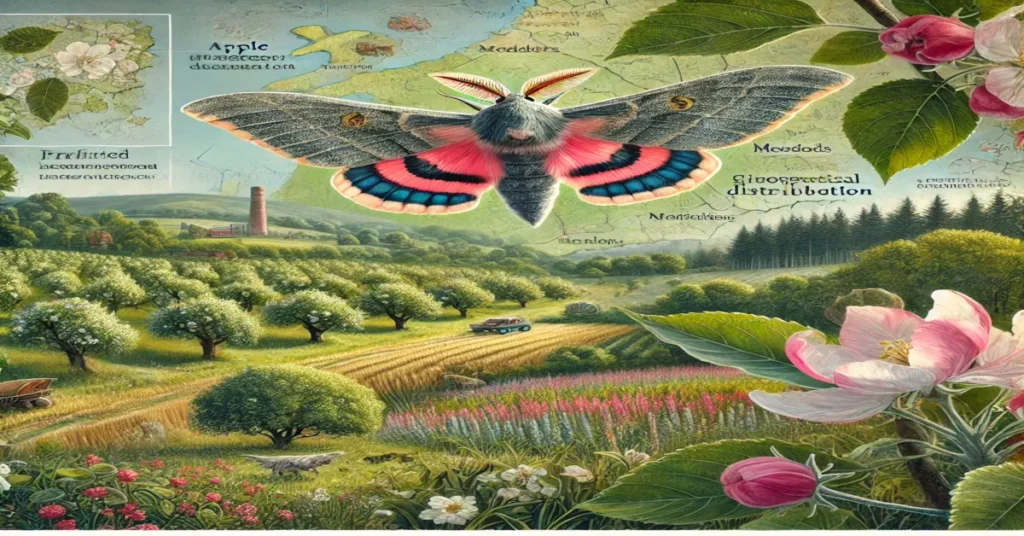
Preferred Habitats
- Orchards and Agricultural Land:
Apple hawkmoths are most commonly associated with apple orchards. These are prime habitats due to the availability of nectar-rich apple blossoms, which the moths pollinate. Apple orchards are generally maintained in temperate regions, and the presence of these orchards ensures a steady food supply for the moths. - Woodlands and Forests:
Apple hawkmoths are also found in woodlands and forests, particularly those with a high density of deciduous trees, such as oak and ash. These areas offer not only flowering plants for the adults but also the host trees that caterpillars rely on for their nutrition. - Riparian Zones:
Areas near streams or rivers with abundant vegetation and diverse plant life also provide habitat for the apple hawkmoth. These environments often contain a variety of nectar-producing plants and ample foliage for the caterpillars. - Suburban and Urban Gardens:
In addition to natural environments, apple hawkmoths can be found in suburban gardens, particularly in regions where gardeners grow plants that attract nocturnal pollinators, such as evening primrose and honeysuckle. Urban green spaces, including parks, also provide suitable conditions for these moths. - Grasslands and Shrublands:
While less common, apple hawkmoths can be found in grasslands or shrublands where wildflowers and other nectar-rich plants grow.
Geographical Distribution
The apple hawkmoth is widespread across temperate and subtropical regions. In North America, it is found predominantly in the United States and Canada, particularly in apple-growing regions such as the Pacific Northwest and the Midwest. In Europe, it is common in apple-producing countries like France, Germany, and the UK. Asia, particularly in countries such as Japan and China, also hosts various species within the Sphingidae family. In Africa, the moth occurs at higher altitudes in regions where temperatures are cooler.
3. Feeding Behavior and Role in Pollination
Apple hawkmoths are predominantly nectarivorous, with their long proboscis designed to feed on the nectar of various flowers. Their feeding behavior, particularly as nocturnal pollinators, plays an essential role in the reproduction of many plants.
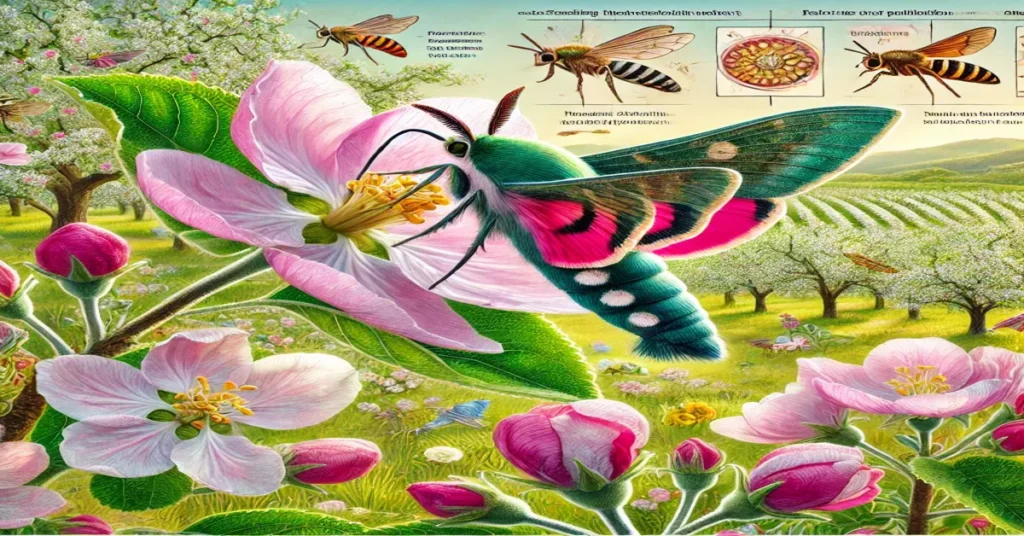
Feeding Behavior
- Nectar Feeding:
The adult apple hawkmoth feeds exclusively on nectar, which provides the energy needed for its flight and reproductive activities. The moth is particularly attracted to flowers with long corolla tubes, such as those found on apple trees, primroses, and evening primroses. The moth uses its long proboscis to reach nectar at the base of the flowers while simultaneously transferring pollen from one flower to another, facilitating pollination. - Pollination Role:
As a nocturnal pollinator, the apple hawkmoth fills a unique niche, pollinating flowers that bloom in the evening or at night. Many of the plants it visits rely on nocturnal insects for pollination because the flowers close during the day or are specialized for night-time pollination. The apple hawkmoth’s role in transferring pollen between flowers ensures that apple trees and other plants can successfully reproduce, producing fruits and seeds that sustain plant populations and food webs. - Larval Feeding:
The larvae are folivores, feeding primarily on the leaves of apple trees and other related plants. The caterpillars typically feed on the leaves until they reach maturity, at which point they undergo metamorphosis to become adults. While the larvae consume the foliage, they rarely cause significant damage to the trees, maintaining a balanced relationship with their host plants.
4. Ecological Role and Contributions
Apple hawkmoths contribute significantly to the ecosystems they inhabit. Their ecological role extends beyond pollination to include nutrient cycling, food web dynamics, and the maintenance of biodiversity.
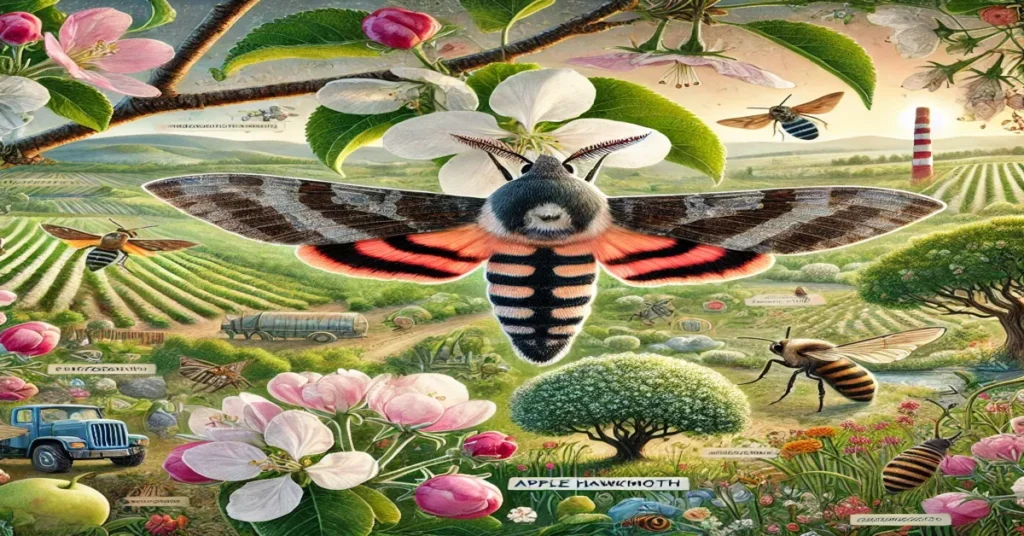
Pollination and Plant Reproduction
The primary ecological role of the apple hawkmoth is as a pollinator. As a nocturnal pollinator, the moth ensures the reproduction of many plants, including apple trees, which are crucial for food production. By transferring pollen as it feeds on nectar, the moth facilitates genetic diversity in plant populations, helping plants produce seeds and fruits that sustain both wildlife and human agricultural systems.
Food Web Contributions
- Prey for Larger Predators:
Apple hawkmoths serve as a food source for a variety of larger predators. The larvae are consumed by birds, small mammals, and parasitoid wasps. The adults are preyed upon by bats and other nocturnal predators. As part of the food web, apple hawkmoths help support populations of other species, contributing to biodiversity. - Nutrient Cycling:
Both the larvae and the adults contribute to nutrient cycling in their habitats. The caterpillars feed on leaves, and upon death, their bodies decompose, enriching the soil with organic matter. This decomposition supports microbial communities that break down plant matter and return vital nutrients to the ecosystem.
5. Adaptations for Survival
Apple hawkmoths are highly adapted to their environments, demonstrating several key survival strategies that allow them to thrive as nocturnal pollinators.

Cryptic Coloration
Both the adult moths and their larvae have evolved camouflage to protect themselves from predators. The moths’ brown and gray coloration blends seamlessly with tree bark, while the larvae’s green bodies with white stripes mimic the appearance of leaves, making them difficult for predators to detect.
Nocturnal Behavior
The apple hawkmoth is primarily nocturnal, a behavior that reduces competition with diurnal pollinators like bees and butterflies. This adaptation also minimizes the risk of predation, as many of their natural predators, such as birds, are inactive at night.
Specialized Feeding Mechanism
The moth’s long proboscis is an evolutionary adaptation that enables it to feed on nectar deep within flowers. This specialized feeding mechanism allows the apple hawkmoth to access nectar that is otherwise out of reach for many other pollinators, thereby reducing competition and making it an efficient pollinator for specific flowers.
6. Threats and Challenges
Despite their ecological importance, apple hawkmoths face several threats that jeopardize their populations.
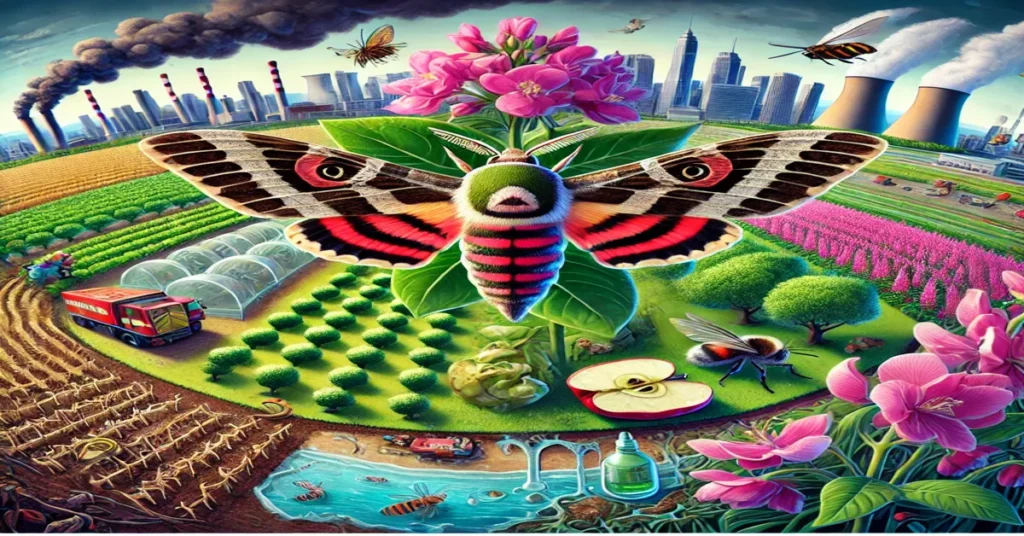
Habitat Loss and Fragmentation
Urbanization, deforestation, and agricultural expansion reduce the availability of suitable habitats for the apple hawkmoth. Loss of orchards and wildflower-rich environments has a direct impact on their populations, particularly as these moths rely on specific host plants for their survival.
Pesticides and Chemicals
The widespread use of pesticides in agriculture poses a significant threat to apple hawkmoths, as these chemicals not only kill the moths but also deplete the nectar resources they rely on for food. The reduction of pollinator populations due to pesticide exposure also disrupts the delicate balance of ecosystems.
Climate Change
Changing climatic conditions, including altered temperature and precipitation patterns, can disrupt the flowering times of plants, affecting the availability of nectar sources for apple hawkmoths. Additionally, climate change can lead to shifts in plant distributions, which may reduce the availability of host plants for the larvae.
7. Conservation Efforts
To preserve apple hawkmoths and their ecological roles, several conservation strategies must be implemented.
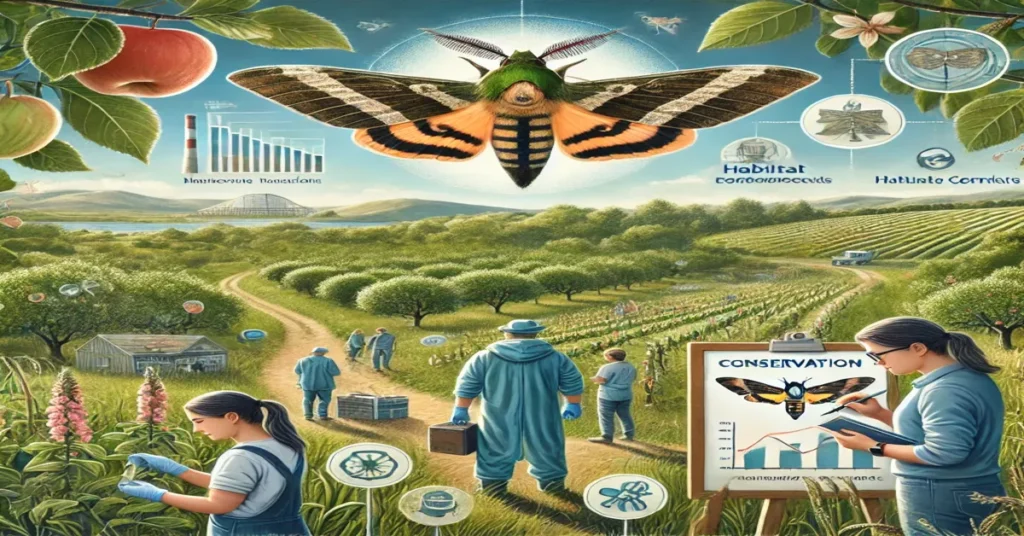
Habitat Restoration
Protecting existing habitats, restoring damaged ecosystems, and planting more nectar-rich flowers in urban and rural areas can provide safe spaces for these moths to thrive. Preserving orchards and natural woodlands ensures that apple hawkmoths have access to both nectar sources and host plants.
Pesticide Reduction
Encouraging the use of Integrated Pest Management (IPM) practices in agriculture can minimize pesticide use and provide a healthier environment for pollinators. Reducing the reliance on harmful chemicals will help maintain populations of beneficial insects like the apple hawkmoth.
Public Awareness and Education
Educating the public about the importance of pollinators in food production and biodiversity can foster more sustainable gardening and farming practices. Public engagement through citizen science programs and outreach can support conservation efforts.
Conclusion
The apple hawkmoth plays an essential role in the ecosystems it inhabits, particularly through its unique role in pollination. By feeding on nectar from flowers and transferring pollen, it helps sustain plant populations and supports food webs across agricultural and natural landscapes. However, this species faces increasing challenges due to habitat destruction, pesticide use, and climate change.
Conserving apple hawkmoths requires integrated efforts, including habitat preservation, sustainable agricultural practices, and public education. By understanding the ecological significance of this moth, we can work towards protecting not only the species itself but also the ecosystems that rely on it for stability.
Read More: Italy Moths: A Fascinating and Crucial Part of the Ecosystem

